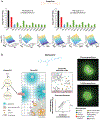Development of New Tuberculosis Drugs: Translation to Regimen Composition for Drug-Sensitive and Multidrug-Resistant Tuberculosis
- PMID: 32806997
- PMCID: PMC7790895
- DOI: 10.1146/annurev-pharmtox-030920-011143
Development of New Tuberculosis Drugs: Translation to Regimen Composition for Drug-Sensitive and Multidrug-Resistant Tuberculosis
Abstract
Tuberculosis (TB) kills more people than any other infectious disease. Challenges for developing better treatments include the complex pathology due to within-host immune dynamics, interpatient variability in disease severity and drug pharmacokinetics-pharmacodynamics (PK-PD), and the growing emergence of resistance. Model-informed drug development using quantitative and translational pharmacology has become increasingly recognized as a method capable of drug prioritization and regimen optimization to efficiently progress compounds through TB drug development phases. In this review, we examine translational models and tools, including plasma PK scaling, site-of-disease lesion PK, host-immune and bacteria interplay, combination PK-PD models of multidrug regimens, resistance formation, and integration of data across nonclinical and clinical phases.We propose a workflow that integrates these tools with computational platforms to identify drug combinations that have the potential to accelerate sterilization, reduce relapse rates, and limit the emergence of resistance.
Keywords: antituberculosis agents; drug development; modeling; pharmacokinetics-pharmacodynamics; simulation; translational science; tuberculosis.
Conflict of interest statement
DISCLOSURE STATEMENT
The authors are not aware of any affiliations, memberships, funding, or financial holdings that might be perceived as affecting the objectivity of this review.
Figures



Similar articles
-
Artificial intelligence enabled parabolic response surface platform identifies ultra-rapid near-universal TB drug treatment regimens comprising approved drugs.PLoS One. 2019 May 10;14(5):e0215607. doi: 10.1371/journal.pone.0215607. eCollection 2019. PLoS One. 2019. PMID: 31075149 Free PMC article.
-
Pharmacokinetics and Drug-Drug Interactions of Lopinavir-Ritonavir Administered with First- and Second-Line Antituberculosis Drugs in HIV-Infected Children Treated for Multidrug-Resistant Tuberculosis.Antimicrob Agents Chemother. 2018 Jan 25;62(2):e00420-17. doi: 10.1128/AAC.00420-17. Print 2018 Feb. Antimicrob Agents Chemother. 2018. PMID: 29133558 Free PMC article.
-
Tuberculosis drugs' distribution and emergence of resistance in patient's lung lesions: A mechanistic model and tool for regimen and dose optimization.PLoS Med. 2019 Apr 2;16(4):e1002773. doi: 10.1371/journal.pmed.1002773. eCollection 2019 Apr. PLoS Med. 2019. PMID: 30939136 Free PMC article.
-
Recent updates on drug resistance in Mycobacterium tuberculosis.J Appl Microbiol. 2020 Jun;128(6):1547-1567. doi: 10.1111/jam.14478. Epub 2019 Oct 29. J Appl Microbiol. 2020. PMID: 31595643 Review.
-
New and Repurposed Drugs for the Treatment of Active Tuberculosis: An Update for Clinicians.Respiration. 2023;102(2):83-100. doi: 10.1159/000528274. Epub 2022 Dec 14. Respiration. 2023. PMID: 36516792 Free PMC article. Review.
Cited by
-
Accelerating TB regimen development: introducing FAST-TB.IJTLD Open. 2024 Nov 1;1(11):483-485. doi: 10.5588/ijtldopen.24.0333. eCollection 2024 Nov. IJTLD Open. 2024. PMID: 39544884 Free PMC article. No abstract available.
-
Strategies for shortening tuberculosis therapy.Nat Med. 2025 Jun;31(6):1765-1775. doi: 10.1038/s41591-025-03742-3. Epub 2025 Jun 13. Nat Med. 2025. PMID: 40514466 Free PMC article. Review.
-
Dose optimization of TBI-223 for enhanced therapeutic benefit compared to linezolid in antituberculosis regimen.Nat Commun. 2024 Aug 25;15(1):7311. doi: 10.1038/s41467-024-50781-4. Nat Commun. 2024. PMID: 39181887 Free PMC article. Clinical Trial.
-
Interleukin-13-Overexpressing Mice Represent an Advanced Preclinical Model for Detecting the Distribution of Antimycobacterial Drugs within Centrally Necrotizing Granulomas.Antimicrob Agents Chemother. 2022 Jun 21;66(6):e0158821. doi: 10.1128/AAC.01588-21. Epub 2021 Dec 6. Antimicrob Agents Chemother. 2022. PMID: 34871095 Free PMC article.
-
Predictions of Bedaquiline and Pretomanid Target Attainment in Lung Lesions of Tuberculosis Patients using Translational Minimal Physiologically Based Pharmacokinetic Modeling.Clin Pharmacokinet. 2023 Mar;62(3):519-532. doi: 10.1007/s40262-023-01217-7. Epub 2023 Feb 19. Clin Pharmacokinet. 2023. PMID: 36802057 Free PMC article.
References
-
- WHO (World Health Organ.). 2019. Global turberculosis report: executive summary. Rep, WHO, Geneva
-
- Merle CS, Fielding K, Sow OB, Gninafon M, Lo MB, et al. 2014. A four-month gatifloxacin-containing regimen for treating tuberculosis.N. Engl. J. Med 371:1588–98 - PubMed
Publication types
MeSH terms
Substances
Grants and funding
LinkOut - more resources
Full Text Sources
Other Literature Sources
Medical

